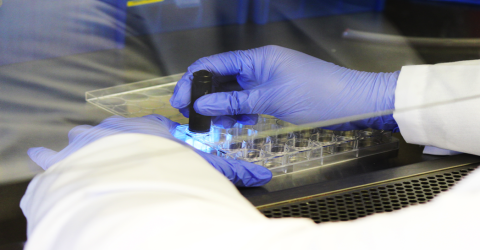Every month, we highlight an outstanding example of UNH intellectual property with excellent commercial potential. Contact unh.innovation@unh.edu for more information about any of UNH's innovations.

A Novel Method for the Production of UV-Curable and Macroprous Injectable Gelatin Hydrogel
Injectable, macroporous, UV-curable hydrogel that adheres to tissues stably. For use in cell-based therapies and tissue engineering.
Benefits
- Macropause
- UV-Curable (quick setting)
- Cost effective
- Highly bio-functional
Intellectual Property Status
Patent Pending
Applications
- Wound healing
- Contact lenses
- Drug Delivery
- Tissue engineering
- Cell culture
Overview
Due to their hydrophilic nature, hydrogels generally absorb a significant quantity of water, making hydrogels beneficial materials to interface human tissues, such as in wound dressings, contact lens, drug delivery, and tissue engineering. Hydrogels can be made injectable through various in situ cross-linking mechanisms and conform to the irregular topography of the applied site. This makes hydrogels an attractive option for use in wound healing applications.
Marketing Opportunity
Injectable hydrogels can be useful tools for facilitating wound healing since they conform to the irregular shapes of wounds, serving as a temporary matrix during the healing process. However, the lack of inherent pore structures of most injectable hydrogels prohibits desired interactions with the cells of the surrounding tissues, limiting their clinical efficacy.
A number of methods have been developed to make macroporous injectable hydrogels in order to enhance the hydrogels’ ability to interact with surrounding cells. Hydrogels that are cross-linked in a frozen state can be thawed and made into a highly porous scaffold, which can be injected through a needle and regain its original shape. However, the shape of the hydrogel must be predetermined, and it is a challenge to tailor the shape of the hydrogel to the wound site.
Photocuring of gelatin-derived injectable hydrogels has been shown to result in inherent pore structures and to enhance wound healing, but the pore size of such hydrogels is not large enough for rapid cell migration as can be demonstrated by the prolonged round cell morphologies when the cells are encapsulated in such hydrogels.
Technology
Researchers at UNH have developed cost-effective, highly biofunctional injectable macroporous hydrogels made of gelatin microgels cross-linked by an enzyme. The hydrogels exhibit pores large enough for cell migration. The viscoelastic properties of these porous hydrogels are similar to those of a nonporous hydrogels produced by adding an enzyme to a homogeneous gelatin solution. The porous hydrogels support a higher cellular proliferation of human dermal fibroblasts (hDFs) than the nonporous hydrogels and allow migration of hDFs into the pores.
The resulting porous hydrogel, comprised of the cross-linked microgels, may be cured using various methods. For example, the porous hydrogel may be allowed to cure “on its own.” Such curing may occur over about 30 minutes. Additionally, the porous hydrogel may be cured using ultraviolet (UV) light over the duration of a few minutes.
In addition to the enzyme-based curing (by microbial transglutaminase or mtg), we incorporated Injectable, macroporous, UV-curable hydrogel that adheres to tissues stably. For use in cell-based therapies and tissue engineering.
Archive
-
2021
- September 2021
Betty and Barney Hill Collection
- MARCH 2021
Innovations in Aqueous Electrochemical Energy Storage Devices
-
2020
- MARCH 2020Viscoelastic Liquid Drop Generator
- February 2020IOL INTACT® Protocol Testing Software
- JANUARY 2020SIMAP®
-
2019
- AUGUST 2019
- JULY 2019
- JUNE 2019
- APRIL 2019
- MARCH 2019
- JANUARY 2019
-
2018
- DECEMBER 2018
- OCTOBER 2018
- SEPTEMBER 2018
- JULY 2018
- JUNE 2018